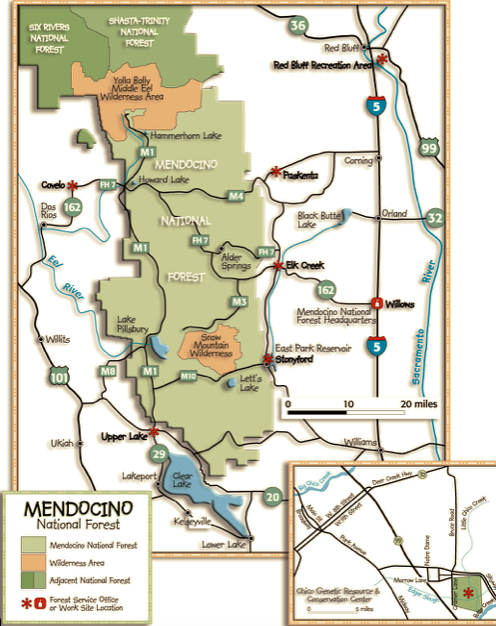The Mendocino National Forest Seeks Public Input on a Vegetation Project

Map depicting where the Mendocino National Forest lies. [screenshot from USDA website]
WILLOWS, Calif. – Jan. 2, 2020 – The Mendocino National Forest is seeking public input on the proposed Ranch Fire Broom treatment project. Forest resource specialists are planning the project to remove and control non-native invasive broom species within the area of the 2018 Ranch Fire. Infestations are known from 15 sites covering 54 acres in various areas of Glenn, Colusa and Lake counties.
Most of this treatment work will involve herbicide application on young plants, though mechanical removal of larger adult plants will also occur. Foliar applications of herbicide to brooms are most effective during late spring and early summer when the plants are actively growing and there is sufficient soil moisture; treatments would generally occur April to July, depending on weather conditions. No herbicide will be applied within Snow Mountain Wilderness and no aerial application of herbicide is proposed.
There are three species of brooms that will be targeted: Scotch broom (Cytisus scoparius), Spanish broom (Spartium junceum), and French broom (Genista monspessulana). Brooms were commonly planted both as ornamentals and for erosion control as early as the late 1800s, but Scotch broom was recognized as a problem in California in the 1930s. Broom species can form impenetrable thickets that contribute to fire hazard, are not palatable to wildlife, and have long-lived seed banks.
The Forest recognizes public participation as a valuable part of the planning process to help refine and further develop the proposed action. To best assist the Forest in this project, please provide comments by January 21, 2020. For more information about the proposal, see the project webpage at https://www.fs.usda.gov/project/?project=57273 or contact District Botanist, Japhia Huhndorf, at [email protected] or 707-275-1426.

Join the discussion! For rules visit: https://kymkemp.com/commenting-rules
Comments system how-to: https://wpdiscuz.com/community/postid/10599/
🕯🌳Good morning Kelley thank you for the information, maybe some Native American input might help.🦄
impossible. the adults have already discharged years of seeds which is why they popped up so fast. every post application report of findings I have ever read concludes with failure and recommends another application or another approach which rarely gets implemented. these herbicides harm everything else in the watershed.
I’ve seen good control of broom by using a combination of pre and post emergents using a emulsified penetrate.
Round up, Crossbow, and Barricade is very effective combined with mechanical cutting of established plants and a fast stump treatment.